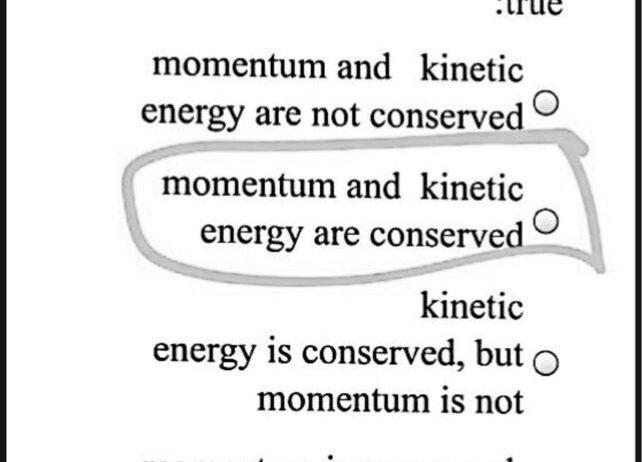When it comes to the mesmerizing realm of physics, collisions represent a fundamental phenomenon that unveils profound principles of momentum and energy conservation. These concepts are pivotal not only in advanced physics but also in our understanding of natural systems, from mundane everyday occurrences to grand celestial events. Within the scope of collisions, the intriguing questions remain: Is momentum conserved? And, is kinetic energy conserved?
To dissect this enigmatically multifaceted topic, we first need to grasp the essential definitions of momentum and kinetic energy. Momentum, denoted by the symbol p, is a vector quantity defined as the product of an object’s mass and its velocity. Mathematically, it can be expressed as p = mv, where m is mass and v is velocity. Kinetic energy, on the other hand, is a scalar quantity, quantified as the energy an object possesses due to its motion, represented by the equation K.E. = ½ mv².
When two objects collide, the subsequent interactions can be categorized broadly into two types: elastic and inelastic collisions. In an elastic collision, both momentum and kinetic energy are conserved. Such collisions are generally idealized scenarios, typically observed in subatomic particles or perfectly rigid bodies. For example, imagine two perfectly smooth billiard balls colliding on a frictionless table. Upon impact, both the total momentum and total kinetic energy of the system before and after the collision remain unchanged.
In stark contrast lies the inelastic collision, a more prevalent scenario in the macroscopic world. In an inelastic collision, momentum is conserved, yet kinetic energy is not. This type of collision often involves elements adhering to each other post-impact, thereby transforming some kinetic energy into other forms, such as thermal energy or sound. Picture a collision where two vehicles collide and crumple upon impact—this is an archetype of inelastic collision. The mangled metal absorbs energy, dissipating it in various ways that do not contribute to the system’s kinetic energy after the clash.
The crux of the matter hinges on understanding how momentum conservation works irrespective of the nature of the collision. The principle of momentum conservation is grounded in Newton’s laws of motion, particularly his third law, which asserts that for every action, there is an equal and opposite reaction. Mathematically, for a closed system comprising two bodies, the momentum before collision equals the momentum after collision:
m₁v₁ + m₂v₂ = m₁v₁' + m₂v₂'Where m₁ and m₂ represent the masses of the two colliding bodies, v₁ and v₂ are their respective velocities before the collision, and v₁’ and v₂’ are their velocities after the collision.
The most fascinating aspect is the universality of momentum conservation. It holds true in any isolated collision process—be it elastic or inelastic. This principle plays a critical role in myriad applications, from analyzing vehicle collisions for safety designs to understanding interstellar phenomena. For instance, the interaction between celestial bodies, such as the merger of stars or the gravitational influences of black holes, can also be analyzed through the lens of momentum conservation.
However, when we pivot our focus to kinetic energy within collisions, the narrative shifts dramatically. In elastic collisions, the complete conversion and re-conversion of kinetic energy demonstrate a transformative aspect of energy conservation. Conversely, in inelastic collisions, kinetic energy is partially obliterated, morphing into alternative energy forms that do not return to full kinetic energy in the aftermath of the collision.
This transformation invites contemplation regarding the implications of energy dissipation. For instance, consider automotive engineering. The design of crumple zones intends to absorb and dissipate energy during collisions, thereby safeguarding passengers within the vehicle. This principle relies on the understanding that while momentum is conserved throughout the event, kinetic energy can, and indeed does, navigate toward more complex forms that enhance safety.
The fascination lies not solely in the definitions or equations but in the broader applications and implications of these concepts. As we probe deeper, we must acknowledge that the conservation laws reflect the underlying harmony and balance within physical systems. The careful interplay of forces shapes not just man-made phenomena but is also exquisite in natural settings, where the collision of celestial bodies orchestrates the cosmic ballet of life and matter.
In conclusion, the dynamics of collisions provide a compelling narrative—bridging critical scientific principles with practical applications that resonate throughout our lives. Understanding the conservation of momentum and the nuanced behavior of kinetic energy fosters a greater appreciation for the world around us. By questioning these fundamental aspects of physics, we not only satiate our curiosity but also gain insights that can inform innovative solutions, whether in sustainability efforts, accident prevention strategies, or advancements in technology. The intersection of physics and real-world implications invites not just inquiry but a promise of transformation, urging us to rethink our approach to energy, matter, and the intricate dance of forces that drive our universe.







